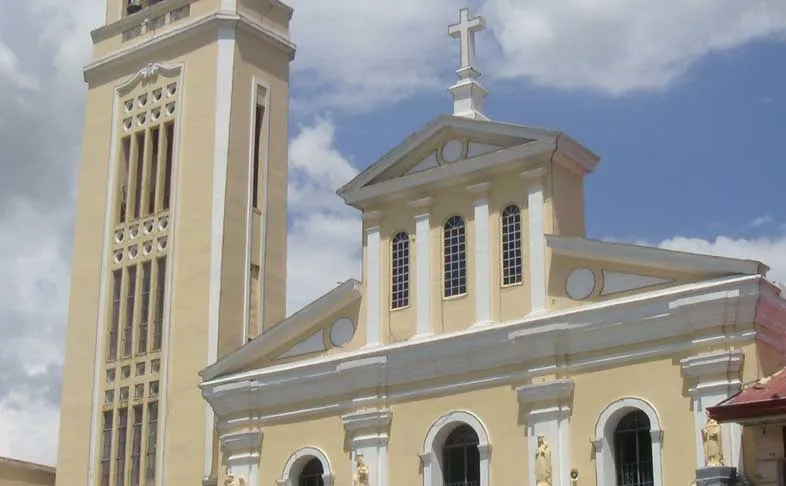
Introduction
The Minor Basilica of Our Lady of the Rosary of Manaoag is one the most visited churches in the Philippines. It is situated on top of the hill of the small town of Manaoag in the Province of Pangasinan. It is where the miraculous image of Our Lady of the Rosary of Manaoag, locally known as Ina’n Birhen na Manaoag or Apo Baket is enshrined. The remarkable long history of the church since the establishment of the mission of Santa Monica by the Augustinian friars when they first arrived in the Province of Pangasinan for evangelization is indeed something to be treasured by the folks of Manaoag.
The Minor Basilica of Our Lady of the Rosary of Manaoag has been canonically affiliated with the Papal Basilica of Saint Mary Major in Rome since June 2011. The parish encompassing Manaoag and the surrounding towns is administered by the Order of Preachers under the Roman Catholic Archdiocese of Lingayen-Dagupan. It was officially declared a Basilica in 2015.
Some of the miracles attributed to Our Lady of Manaoag are depicted in murals inside the church’s transepts and nave. The Paschal Chapel beside the south flank of the church has icons of the Black Nazarene similar to that of the Quiapo Church, the Santo Entierro (Dead Christ), and other statues of the Virgin Mary. The sanctuary on the left side of the main entrance has a large image of the Crucified Christ.
Behind the church are the Parish Office, Museum of Our Lady of The Rosary of Manaoag, Candle Gallery, Pilgrims’ Center and Rosary Garden. There is also an Information Center at the Priory at the left side of the church and souvenir shops at the front office of the church, beside the Veneration Room at the second floor behind the main sanctuary, and at the Candle Gallery in the space behind of the church.
History of Minor Basilica of Manaoag

Historically, when the Augustinians arrived in Pangasinan to evangelize in 1575, they established the mission of Lingayen, Bagnotan (now Dagupan) and Santa Monica (now Manaoag). However, they left because of the resistance of the Pangasinenses who remained in their paganism.
There were other undocumented missionaries who ministered in Pangasinan. The Franciscans also attempted to evangelize the Province. However, their efforts were futile as they were not able to convert the natives of Pangasinan. Subsequently, in 1587, the Dominican Missionaries established their mission in Binalatongan (now San Carlos) under the patronage of their founder Saint Dominic De Guzman.
The Dominicans also started mission in Mangaldan which is 9 km from Santa Monica that was administered as “visita” to the Augustinian convent of Lingayen. Considering the distance (30 km) of Lingayen to Santa Monica, the Augustinians willingly surrendered its ministration to the hands of bishop of Nueva Segovia, Bishop Diego de Soria, OP, who in turn assigned it to Fr. Juan de San Jacinto, OP, who was the Vicar of Mangaldan. Thus, when the Dominicans accepted this mission in 1605, Fr. de San Jacinto thought of building a chapel dedicated to Our Lady of the Rosary.
Tradition holds that the name of the town, Manaoag, came from the story of apparition of the Blessed Virgin Mary to a farmer on a treetop. The story relates that in the center of a cloud appeared the Virgin of the Rosary and her most holy Son. She expressed her wish that a shrine be erected in her honor in that same place, where her devotees could go in the future, to implore her maternal protection.
Numerous threats from the Igorot tribes of the surrounding mountains led to the transfer of the entire community to the present site on a hill. The Dominicans started to build a large church on its present site in 1701 under the sponsorship of Gaspar de Gamboa and his wife, Agata Yangta, who were wealthy residents from Manila who moved to Lingayen. Later expansion of the church from 1882 was frustrated by an earthquake in 1892.
During the tumult of the Philippine Revolution for independence from Spain, revolutionaries set fire to the church, its treasures, ornaments, and records on 10 May 1898. The image narrowly escaped destruction; it was found abandoned at the back of the church. It was spirited away to Dagupan City, where it was kept from June to October 1898.
The Dominicans returned in 1901 upon the invitation of Rev. Mariano Pacis, the diocesan priest of Manaoag. Under the aegis of the Dominicans, the church that was started in 1882 was finally completed to a large extent in 1911-12. The central retablo, incorporating Baroque columns from the 18th-century altar, was completed by the famed Tampinco Atelier of Manila. The transepts were completed in 1931-32.
The Dominicans ceded all their Pangasinan missions to the diocesan clergy except Manaoag. Spiritual administration of the shrine in perpetuity was granted by the Holy See to the Order of Preachers in 1925.
A huge crowd attended the Canonical Coronation of the image on 21 April 1926 by then-Apostolic Delegate to the Philippines Guglielmo Piani, S.D.B., as authorized by Pope Pius XI. This meant that the Catholic Church officially recognized and proclaimed that The Virgin Mary acclaimed as Our Lady of The Rosary of Manaoag had granted favors and blessings to or formidable intercessions for her devotees through the centuries.
The church was rebuilt after surviving Japanese bombardment during the Second World War. The old convento is now the Our Lady of Manaoag College, founded as Holy Rosary Academy in 1946 by the last Spanish Dominican in Manaoag, Rev. Teodulo Cajigal, O.P.
Since 8 December 1972, the Shrine of Our Lady of the Rosary of Manaoag has been under the Philippine Dominican Province. It celebrated the Diamond Jubilee of the image’s canonical coronation on 1 January 2000.
Architecture of Minor Basilica of Manaoag
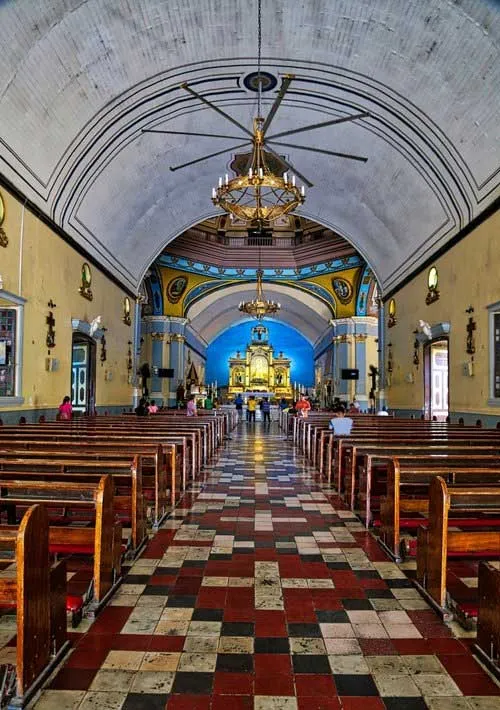
The Dominican Community who administers the Basilica has never stopped in their mission and vision – to preach the Gospel of Jesus and to evangelize the people of Manaoag and the pilgrim people of God. Regular masses and other religious activities in the parish keeps the Basilica in communion with the Church. Recently, improvements and innovations have been implemented to create a more conducive place for prayer and worship. After every mass a Blessing Prayer is said for the sick and religious articles are sprinkled with holy water. Outside, vehicles are blessed in an organized manner.
Ushers and usherettes are stationed inside the church to provide a prayerful and orderly visit to the Basilica. They also serve as guides for the pilgrims, especially for the first timers. During the pandemic, they make sure that the health and safety protocols of the Basilica are maintained by sanitizing the pews inside the church after every mass. With their efforts, we hope to offer the pilgrims a memorable visit to the Basilica, where they can pray and practice their Catholic faith. When the church is full, the Basilica has created more open spaces beside the church to accommodate more people to participate in the holy mass.
The Basilica also maintains the upkeep of the facilities and surroundings of the church. The souvenir shops of the Basilica offer a variety of religious articles, prayer booklets and novenas as well as candles which pilgrims can light with a fervent prayer at the Candle Gallery. Although the veneration area of Our Lady of the Rosary of Manaoag at the back of the retablo is temporary closed due to the pandemic, people can still get a little bit closer to Our Lady in front of her throne, to ask for her intercession.
The Basilica will always be a channel of hope, providing spiritual growth to all who come and visit Our Lady of the Rosary of Manaoag. Truly, Our Lady of the Rosary does not and will never cease calling her children. In turn, her children, the people of God, cannot refuse her calling, not even with hardship and sacrifice, just to visit her in her shrine and to seek her intercession.
Canonical Affiliation with Saint Mary Major

On 21 June 2011, Cardinal Bernard Francis Law, Archpriest of the Papal Basilica of Saint Mary Major in Rome and Pope Benedict XVI canonically approved the granting of a “Special Bond of Spiritual Affinity in Perpetuity” through which the pilgrims are assured of the same blessings and entitlement to a plenary indulgence equal to that received when visiting a papal basilica in Rome. This was confirmed by the prelate (now Archbishop) of the Lingayen-Dagupan, Socrates B. Villegas, in a circular dated June 13, 2011.
The Manaoag Shrine is the first to achieve this status followed by the Shrine of Our Lady of Caysasay in Taal, Batangas in June 2012. The official document and a shrine official, who was among the priests who went to Rome, confirmed that a plenary indulgence (of a maximum of one per day) may be obtained on each visit to the Shrine in a spirit of detachment from the attraction of sin subject to three conditions for each occasion: going to confession immediately before or after the pilgrimage; attending a Mass and receiving the Eucharist during the pilgrimage; and praying for the intentions of the Pope at the Shrine.
Elevation to Basilica
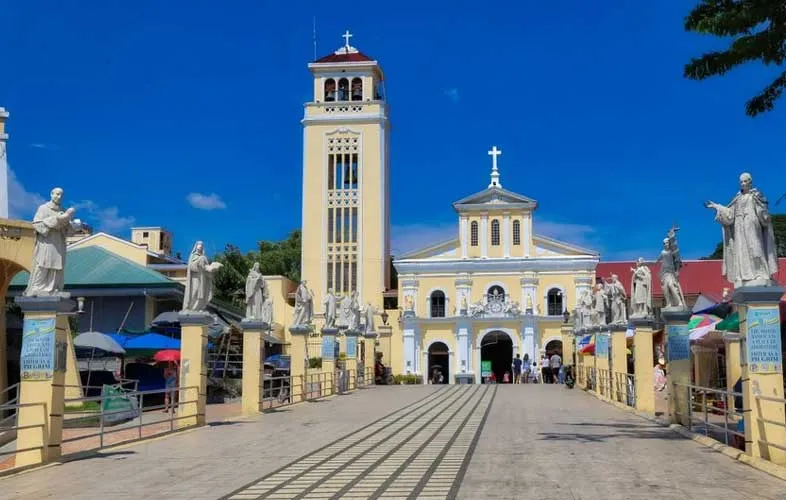
In February 2015, the Shrine of Our Lady of The Rosary of Manaoag was elevated to a minor basilica in a ceremony attended by more than 100 archbishops and bishops, leaders of church and state, and numerous devotees. The Shrine was henceforth called the Basilica of Our Lady of The Rosary of Manaoag, headed by a rector appointed by the Archbishop of Lingayen-Dagupan. A special Mass was also held to affirm the “Special Bond of Spiritual Affinity in Perpetuity” between the Manaoag Shrine and the Papal Basilica of Saint Mary Major in Rome.
Our Lady of Manaoag

Our Lady of Manaoag (formal title: Our Lady of the Most Holy Rosary of Manaoag; Spanish: Nuestra Señora del Santísimo Rosario de Manaoag) is a Roman Catholic title of the Blessed Virgin Mary venerated in Manaoag, Pangasinan, the Philippines.
The ivory and silver image which bears its title dates from the 16th century and is presently enshrined within the Minor Basilica of Our Lady of the Most Holy Rosary of Manaoag. The shrine is a major pilgrimage site in the country and is administered by the Order of Preachers within the Archdiocese of Lingayen-Dagupan.
Pope Pius XI granted a Canonical Coronation to the image on 25 August 1925. The rite of coronation was executed on 21 April 1926, while Pope Benedict XVI raised her sanctuary in equal indulgences to the Basilica of Saint Mary Major on 21 June 2011. Under this Marian title, the Blessed Virgin Mary is invoked as patroness of the sick, helpless and needy, The of the image is celebrated twice a year: the third Wednesday after Easter and first Sunday of October.
Etymology
Tradition holds the town of Manaoag was derived from the Pangasinense verb mantaoag, which means “to call”.
The Statue of Our Lady of Manaoag
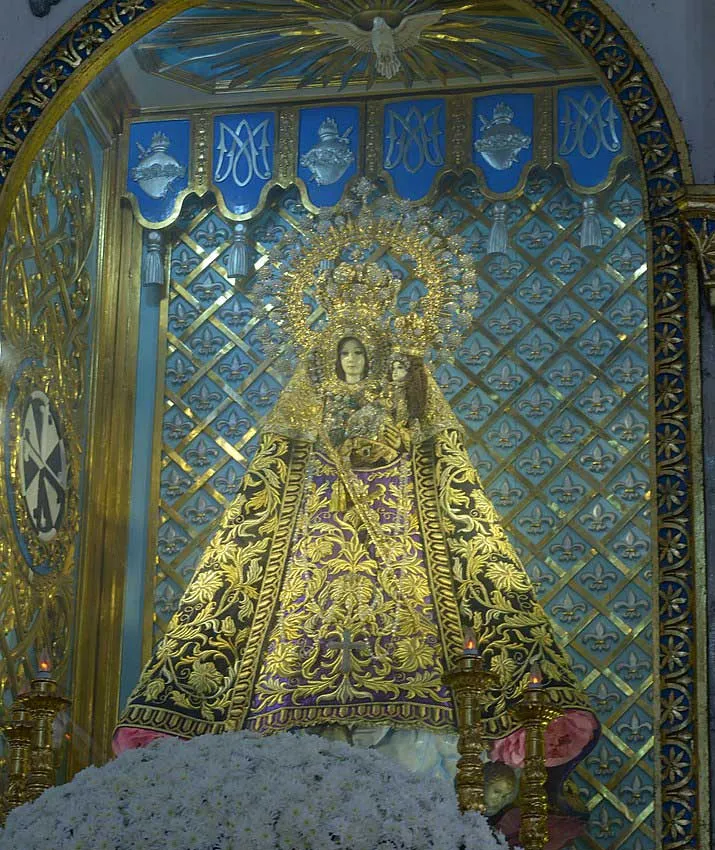
The statue of Our Lady of Manaoag is a 17th-century ivory and silver image of the Virgin Mary with The Child Jesus enshrined at the high altar of the Basilica. It was brought to the Philippines from Spain via the Manila galleon trade from Acapulco, Mexico, in the early 17th century by Padre Juan de San Jacinto.
Documents dating back to 1610 attest that a middle-aged farmer walking home heard a mysterious female voice. He looked around and saw on a cloud-veiled treetop an apparition of the Virgin Mary, holding a Rosary in her right hand and The Child Jesus in her left arm, all amidst a heavenly glow. Mary told the farmer where she wanted her church to be built, and a chapel was built on the hilltop site of the apparition, forming the nucleus of the present town.
Our Lady of the Rosary is depicted in other countries with similar attributes, with the accoutrement and style of the vestments varying across cultures. The Manaoag image is distinct from other statues in its sculpture and regalia, particularly its crown.
A pilgrim replica of the image also exists and is toured around parishes in the Philippines for veneration.

Regalia and Security
The image of Our Lady of Manaoag and her bejeweled crown are considered priceless. There have been several attempts to burglarize the Manaoag Shrine of the jewels sewn into the icon’s dress and set into its regalia which include crowns, halos, rosary, scepters, and marshal’s baton.
Several of her golden crowns and halos are deposited at the shrine’s museum, donated by both local and foreign devotees. An expensive collection of liturgical vestments that have been used by the image and the Dominican priests are also on display, as are an array of perfumes used to anoint the image. These are ex-votos given by devotees and pilgrims from around the world.
The image of Our Lady of Manaoag is fully secured within a bulletproof glass enclosure above the new high Altar, which has additional wood carvings, an elevated pedestal, and four golden candelabras. The coat-of-arms of the Dominicans is embedded above the image’s window as a demonstration of the Order’s devotion to her. The bas-relief, made of narra carvings beneath her throne that beautifully depicts the historic events in the devotion to Our Lady, has been refurbished.
The archdiocese, in line with the Filipino custom of venerating an image by touching its body or clothing, constructed a staircase that rises to the Veneration Room on the second floor behind the apse. The room has pews in front of the alcove behind the image’s shrine. Supplicants kneel before the glass small window behind the image’s base to pray and touch the hem of the image’s mantle, often dropping written prayers into a nearby box. After venerating the image, devotees pass through the religious goods shop on their way out.

Veneration - Miracles
Some of the earliest miracles attributed to Our Lady of Manaoag, including the original apparition, are depicted in the murals in the church.
In the early days of the Spanish era, animist mountain tribes burnt down newly-Christianized villages. The town of Manaoag was among the settlements that were burnt by the raiders, sending the locals fleeing to the thatch-roofed church. The pillagers’s leader climbed over the church compound’s crude fence and shot flaming arrows at all parts of the church, but the building miraculously did not catch fire.
During the Second World War, enemy Japanese forces dropped several bombs within the church’s vicinity. The structure was only moderately damaged. Four bombs were released above the church, with three landing on the plaza and the facade, destroying both. The last bomb fell into the sanctuary, but miraculously did not explode. The supposed presence of chrysanthemum flowers in the church prevented the Japanese soldiers from doing acts of desecration, due to the flower being revered in their culture.
Other miracles recounted and attributed to the Lady of Manaoag includes rainfalls during droughts, reviving an already-dead boy through holy intercession and holy water, stopping a fire that originated from the church, and resisting various attempts at relocating the shrine.
Miracles attributed to the Lady of Manaoag in modern times are widespread, attested by believers and widely promoted by word of mouth, publications and legends. As such, pilgrims often invoke Her intercession in times of dire need, with some of the petitioners travelling all the way from far places to do so.
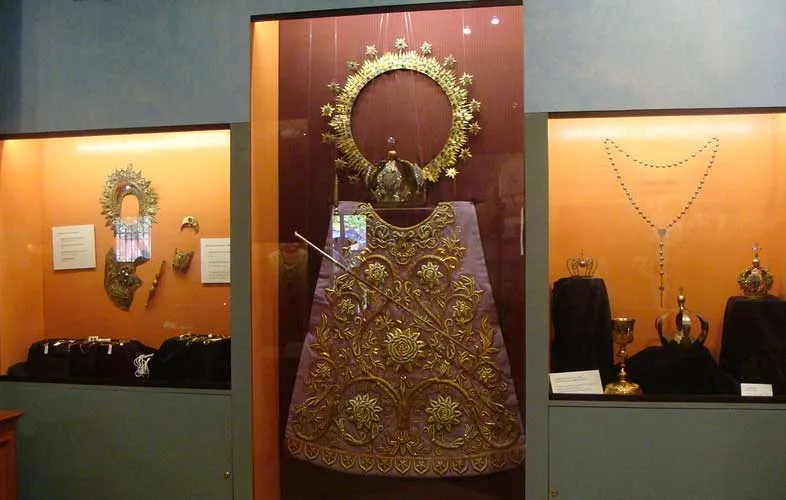
Services
Thousands converge on Saturdays and Sundays to pray for their intentions, hear Mass, pray the Rosary, offer flowers, light candles, buy religious articles, have religious articles or vehicles blessed, get holy water, and join in the daily and seasonal activities. The blessings of religious articles and vehicles are performed at the back of the church grounds after every Mass, while holy water is also dispensed there for free to those with containers.
The short dawn procession and Scriptural Rosary every first Saturday before the 5 a.m. Mass is well-attended by regular pilgrims mostly from Metro Manila and from Regions I (Ilocos), II (Cagayan Valley), and III (Central Luzon). These first Saturday rites are pursuant to the Communion of Reparation on the First Saturdays requested by the Virgin Mary in her third apparition at Fátima on 13 July 1917 for the preservation of world peace.
Any of the Masses in the regular schedule may be offered for personal petitions and thanksgiving. The 7 a.m. Masses on Fridays (except on Good Friday) may be offered for the soul in Purgatory of a dearly departed. These may be done through the parish office at the right side of the main entrance of the church; at the Shrine Museum; or at the back of the church beside the religious store at the entrance of the Candle Gallery. Mass offerings and donations may be offered also through its website.
Services at the shrine and religious programming are broadcast on Radyo Manaoag 102.7 FM, which is also accessible through the shrine’s official website.
In Guam
A three-foot replica of the image of Our Lady of Manaoag was donated by a devotee and traveled to the United States unincorporated territory of Guam on 17 August 2012. The statue was enshrined at the Saint Anthony of Padua and Saint Victor Catholic Church in Tamuning, Guam where a dedication rite was held the following day, attended by Filipino-Guamanian Catholics. The statue traveled as a paid passenger aboard a United Airlines flight.
Feast Day
The primary feast of Our Lady of Manaoag is on the third Wednesday of Easter. The peaks of the pilgrimages are during the Lenten and Easter seasons, the month of May, and the month of October – the month of The Holy Rosary – where the universal feast day of Our Lady of The Holy Rosary is celebrated every first Sunday of October. There is a procession after the afternoon Mass on these occasions.
Mass Time
Weekdays
- 6:00 am
- 7:30 am
- 9:00 am
- 10:30 am
- 4:30 pm
Sundays
- 6:00 am
- 7:30 am
- 9:00 am
- 10:30 am
- 12:00 (Noon)
- 3:00 pm
- 4:30 pm
Church Visiting Time
- Every Days : 4:00 am to 6:30 pm
- Tuesdays : 4:00 am to 6:00 pm
Contact Info
Milo Street, Manaoag, Poblacion,
2430 Pangasinan, Philippines.
Phone No.
Tel : +63 75 529 0132
Accommodations
How to reach the Minor Basilica
Clark International Airport, known as Diosdado Macapagal International Airport located at the Clark Freeport Zone in the province of Pampanga, Philippines is the nearby Airport to the Minor Basilica.
PNR Mangaldan Train station in Mangaldan, Philippines is the nearby Train station to the Minor Basilica.

